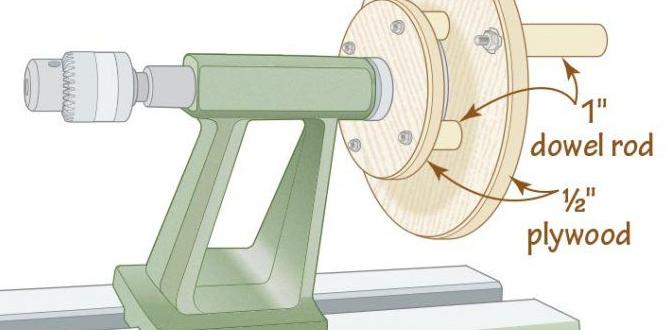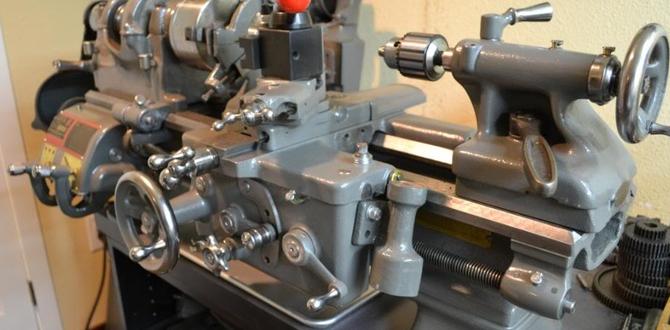Quick Summary: This guide shows you how to select and use a 1/8-inch carbide end mill with a 1/2-inch shank on polycarbonate to minimize deflection, ensuring cleaner cuts and better results for your projects.
Hey there, fellow makers and tinkerers! Daniel Bates here, your guide from Lathe Hub. Ever faced that frustrating wobble when trying to cut through tough materials like polycarbonate? That pesky deflection can ruin a clean edge and waste your hard work. Today, we’re diving deep into a specific tool that, when used right, can make a world of difference: the 1/8-inch carbide end mill with a 1/2-inch shank, especially when you need that extra reach. We’ll break down exactly why this tool is a game-changer for polycarbonate and how to wield it effectively and safely. Get ready to take your precision cutting to the next level!
Understanding the Challenge: Cutting Polycarbonate with Small End Mills
Polycarbonate, also known as Lexan, is a fantastic material for many projects. It’s incredibly strong, impact-resistant, and can be transparent, making it perfect for machine guards, lenses, and creative enclosures. However, it’s also a bit of a different beast to machine compared to softer plastics or metals. It’s prone to melting if too much heat is generated, and delicate cuts can easily suffer from something called “deflection.”
Deflection happens when the cutting force of the tool bends or pushes the material away. For a small end mill, especially one with an extended reach, this force can be amplified. Imagine trying to push a long, thin stick through thick mud – it’s going to wiggle and bend, right? The same principle applies here. When your tiny 1/8-inch end mill bends, your cut won’t be precise. You might get fuzzy edges, rough surfaces, or even chip the material. This is where choosing the right tool and understanding how to use it becomes crucial, especially when you need that extra length from a 1/2-inch shank.
Why a 1/8-Inch Carbide End Mill with a 1/2-Inch Shank is Your Go-To for Polycarbonate
Let’s talk about the specific tool: a 1/8-inch diameter carbide end mill with a 1/2-inch shank, often described as “extra long.
- Carbide Material: This is key. Carbide is much harder and more rigid than High-Speed Steel (HSS). This means it retains its sharpness longer, can withstand higher cutting temperatures, and most importantly, it deflects less than HSS. For precision work on plastics like polycarbonate, carbide is almost always the superior choice.
- 1/8-Inch Diameter: This small diameter is ideal for detailed work, small features, and tight corner radii. It allows for intricate designs and isn’t overkill for many polycarbonate parts.
- 1/2-Inch Shank: This is where the “extra long” description comes in. A standard end mill might have a 3/8-inch or even a 1/4-inch shank for a 1/8-inch cutter. The 1/2-inch shank provides a much more robust connection to your collet or tool holder. This increased rigidity is vital. A thicker shank means less vibration and less potential for the end mill itself to flex, even when it’s extended.
- “Extra Long”: This implies the flute length (the part with the cutting edges) is also extended beyond a standard end mill of this diameter. While offering greater reach is its benefit, it also means this extended flute is more susceptible to deflection if not used carefully. The combination of the thick shank and the extra-long flute is what we need to manage.
Minimizing Deflection: The Art of the Cut
So, how do we harness the power of this tool and fight that dreaded deflection? It’s a combination of tool selection, machine setup, and cutting strategy. Remember, the goal is to remove material efficiently while keeping the tool and the material stable.
1. Choosing the Right End Mill Geometry
Not all carbide end mills are created equal. For polycarbonate, you want to look for specific features in the end mill’s design:
- Number of Flutes: For plastics, especially softer ones like polycarbonate, fewer flutes are generally better. A 2-flute or 3-flute end mill is usually preferred over a 4-flute. Why? Fewer flutes mean larger chip evacuation spaces. This is critical because melted plastic can quickly clog up flutes, leading to poor surface finish and tool breakage. More space for chips to escape means cooler cutting and a cleaner cut.
- Polish/Coating: A highly polished flute or a special coating (like TiN or ZrN, though a plain polished uncoated carbide is often best for plastics) can reduce friction and prevent material buildup. This helps the plastic “flow” off the tool rather than stick to it.
- Helix Angle: A moderate helix angle (e.g., 30-45 degrees) is often a good compromise for plastics. A very steep helix can be too grabby, while a very shallow one might not cut as cleanly.
2. Machine Setup and Workholding
A stiff machine and solid workholding are non-negotiable. Even the best end mill will deflect if your machine has play in the axes or your workpiece is loose.
- Rigidity: Ensure your CNC machine or milling machine is in good working order. Check for any gib adjustment or ways that might be loose. A machine that feels solid when you push on it is a good sign.
- Tool Holder/Collet: Use a high-quality, precision collet or tool holder. If your tool holder has runout (the tendency for the tool to wobble even when properly inserted), your end mill will cut erratically, and deflection will be worse. A set of ER collets is a great investment for precision machining.
- Workpiece Clamping: Your polycarbonate sheet must be held down securely. Use clamps that don’t interfere with the cutting path, or consider using double-sided tape on a sacrificial base if you can’t clamp it directly. Any movement of the workpiece is your enemy.
For a detailed guide on selecting high-quality collets and tool holders, check out resources from reputable machining suppliers. Companies like Grizzly Industrial or Haas Automation (for CNC aspects) often have excellent product information and guides relevant to tool holding and machine setup.
3. Cutting Strategy: The “How”
This is where we focus on minimizing forces and managing heat. The extra-long nature of your end mill means we need to be particularly mindful of its unsupported length.
- Depth of Cut (DOC): This is arguably the most critical parameter. For small end mills, and especially when they are extended, you need to take shallow depths of cut. Trying to cut too deeply in one pass will overload the tool and cause massive deflection. Start shallow – think 0.020″ to 0.050″ (0.5mm to 1.2mm) for a 1/8″ end mill.
- Stepover (Width of Cut – WOC): This is how much the end mill moves sideways in each pass. For polycarbonate, you generally want a relatively small stepover, perhaps 20-40% of the tool diameter. A smaller stepover means more passes but less side force on the tool, reducing deflection.
- Feed Rate: This is the speed at which the tool moves through the material. You need to balance chip load (the amount of material each cutting edge removes per revolution) with heat generation. For polycarbonate, a moderate feed rate that creates a light, wispy chip is usually good. Avoid rubbing the material. Too slow a feed rate will cause the tool to melt the plastic instead of cutting it.
- Spindle Speed (RPM): This is closely tied to feed rate. For plastics, maintaining a good surface speed is important. While it’s tempting to crank up the speed, it can generate heat. For a 1/8″ carbide end mill on polycarbonate, start in the range of 10,000 – 20,000 RPM, but be prepared to adjust based on chip formation and sound.
- Climb Milling vs. Conventional Milling: For most plastics, climb milling is preferred. In climb milling, the cutter rotates in the same direction as its feed movement. This results in a shearing action that produces a cleaner surface finish and produces less heat than conventional milling (where the cutter fights against the feed direction).
4. Tool Engagement: Lead Angle and Pecking
How the end mill enters the material matters. With an extra-long tool, you want to be gentle.
- Lead Angle: If your CNC controller allows, entering the material with a slight lead angle (ramping into the material at an angle) can be smoother than plunging straight down. For this specific tool and material, ramping is often better than a straight plunge.
- Pecking/Ramping for Slots: When cutting slots or pockets, instead of plunging straight down, ramp the end mill into the material. This distributes the cutting load over a longer path.
5. Cooling and Lubrication
Heat is the enemy of clean plastic machining. While not always practical in a home workshop, some form of cooling can help.
- Compressed Air: A blast of compressed air directed at the cutting zone is the most common and effective method for plastics. It blows chips away and cools the cutter and workpiece.
- Cutting Fluids (Use with Caution): Some machining fluids can be used, but be very careful with polycarbonate. Many petroleum-based ones can craze or damage the plastic. Water-based coolants can work, but ensure they are compatible with polycarbonate. Often, simple air cooling is best.
Example Workflow: Cutting a Small Bracket from Polycarbonate
Let’s put this into action. Imagine you need to cut a small, intricate bracket from a 1/4-inch thick sheet of polycarbonate.
| Parameter | Recommended Setting | Reasoning |
|---|---|---|
| Material | 1/4″ Polycarbonate | Standard engineering plastic, prone to melting and deflection. |
| Tool | 1/8″ 2-Flute Carbide Extra Long End Mill, Polished | For detail, good chip clearance, rigidity from shank, less deflection. |
| Collet/Holder | Precision ER-20 Collet (or similar) | Minimizes runout, ensures concentricity. |
| Workholding | Clamps or strong double-sided tape on spoilboard | Absolute stability is required. |
| RPM | 15,000 | Good balance of cutting speed and heat generation. |
| Feed Rate | 30 inches per minute (approx. 762 mm/min) | Creates a light chip load, avoids rubbing. (This is a starting point, adjust based on sound/chip). |
| Depth of Cut (DOC) | 0.040″ (1mm) | Shallow cut to prevent excessive tool bending. |
| Stepover (WOC) | 0.040″ (1mm) – 30% of dia | Reduces sideward force, improves finish. |
| Cutting Motion | Climb Milling | Cleaner surface, less heat generated. |
| Engagement | Ramp into material (e.g., 5-degree angle) or use arc-fitting entry. | Gentle entry to avoid shock loading. |
| Cooling | Compressed Air | Blows chips away, cools cutter. |
Note: These settings are starting points. Always perform a test cut on scrap material and listen to the sound of the cut. If it sounds “grabby” or “rubby,” adjust feed rate or DOC. If chips are melting, increase air blast or consider a slightly higher feed rate.
Alternative Tools and When to Use Them
While the 1/8-inch extra-long carbide end mill is excellent for detailed work on polycarbonate, it’s not the only tool. Depending on your project, other options might be relevant:
- Shorter 1/8″ End Mill: If your project doesn’t require a deep pocket or cutting through thick material, a standard 1/8″ end mill with its full shank length seated firmly in the collet will deflect even less.
- Larger Diameter End Mills (e.g., 1/4″): If your part design allows, using a larger diameter end mill can often result in less deflection for the same depth of cut because the tool is inherently more rigid. However, this sacrifices detail.
- O-Flute or Single Flute Cutters: These are specifically designed for plastics. They have a single, large flute and are optimized for fast material evacuation and smooth cuts. They often have a highly polished finish. If you’re doing a lot of plastic work, investing in a few O-flute cutters can pay dividends. For polycarbonate, a 1/8″ O-flute or 2-flute polished end mill is your best bet.
- Drills: For making holes, always use appropriate drill bits, not end mills. Drill bits are designed for plunging into material and for creating round holes.
Choosing the right tool depends entirely on the machining task. For detailed profiling and pocketing of polycarbonate, the 1/8-inch carbide end mill with a stout shank is a fantastic choice. For further exploration into specialized plastic cutting tools, resources from manufacturers like YG-1 Tool or Harvey Tool often provide detailed specifications and application notes.
Safety First: Machining Practices
Working with any machine tool carries inherent risks. Safety should always be your top priority. Here’s how to stay safe:
- Eye Protection: Always wear safety glasses, and ideally a full face shield when operating any machining equipment. Small chips and debris can fly at high speeds.
- No Loose Clothing or Jewelry: These can get caught in rotating machinery. Tie back long hair.
- Secure Workpiece: A loose workpiece is a projectile hazard. Ensure everything is clamped down firmly.
- Sharp Tools: Dull tools require more force, generate more heat, and are more likely to break, increasing the risk of injury. Keep your end mills sharp and in good condition.
- Machine Guarding: Ensure all machine guards are in place and functioning correctly.
- Know Your Machine: Understand the emergency stop procedures for your specific machine. Never leave a running machine unattended.
- Understand Tool Breakage: If an end mill breaks, stop the machine immediately and wait for it to come to a complete stop before attempting to clear debris.
For comprehensive safety guidelines, consulting resources from the Occupational Safety and Health Administration (OSHA) on machine guarding and safe operating procedures is advisable, even for hobbyists.
Troubleshooting Common Issues
Even with the best practices, you might encounter problems. Here’s how to tackle them:
Problem: Fuzzy or Rough Edges on Polycarbonate
- Cause: Tool is dull, tool is deflecting, rubbing instead of cutting, too much heat.
- Solution:
- Ensure end mill is sharp and clean.
- Reduce depth of cut and stepover.
- Increase feed rate slightly, or decrease RPM if melting occurs.
- Ensure effective chip evacuation and cooling (compressed air).
- Try climb milling.
Problem: End Mill is Melting the Plastic
- Cause: Too much friction, inadequate chip load, tool rubbing.
- Solution:
- Increase feed rate.
- Decrease RPM.
- Ensure effective air blast is cooling the cutting zone.
- Check for a properly polished end mill; recut material buildup can occur on dull or coated tools.
Problem: Tool Chattering or Vibrating
- Cause: Loose machine components, flex in the tool/spindle, too aggressive cut parameters, workpiece not secured.
- Solution:
- Check machine gibs and tool holder security.
- Reduce depth of cut.
- Ensure workpiece is rock solid.
- Try a slightly different feed rate or RPM to “tune out” the vibration.







